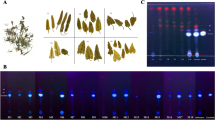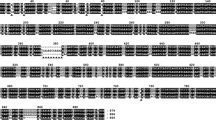Abstract
Cnidium monnieri (L.) Cusson, a widely distributed plant, has been used in traditional Chinese medicine for a long time. For its medicinal values reflected by chemical variation, researches on high-performance liquid chromatographic (HPLC) fingerprinting and molecular markers of chloroplast DNA (cpDNA) were carried out. In the research, we analyzed the chemical composition qualitatively and quantitatively, and amplified the fragment of trnL-trnF and trnS-trnG in C. monnieri from twelve populations throughout the known distributions in China to make a better understanding of the chemical variance and evolutionary history and to reveal the genetic mechanism of the chemical variance in C. monnieri. The results suggested chemical variance and high genetic diversity with a significant phylogeographical pattern (NST > GST, P > 0.05), which showed restricted gene flow among the populations and significant geographical or environmental isolation. Climatic difference might play a key role in the present distribution of the species, resulting the chemical variance in the C. monnieri. These findings not only provide some references for evaluating the medicinal quality and selecting C. monnieri (L.) Cusson with good pharmacological properties, but also elucidate the evolutionary history of this medicinal herb and provide guidance for the methods of resource conservation.





Similar content being viewed by others
Availability of Data and Materials
All data generated or analyzed during this study are included in this article and its supplementary information files.
References
Avise J (2000) Phylogeography: the history and formation of species. Harvard University Press
Balloux F, Lugon-Moulin N (2002) The estimation of population differentiation with microsatellite markers. Mol Ecol 11(2):155–165. https://doi.org/10.1046/j.0962-1083.2001.01436.x
Basnet P, Yasuda I, Kumagai N, Tohda C, Nojima H, Kuraishi Y, Komatsu K (2001) Inhibition of itch-scratch response by fruits of Cnidium monnieri in mice. Biol Pharm Bull 24(9):1012–1015. https://doi.org/10.1248/bpb.24.1012
Berenbaum MR, Zangerl AR (1998) Chemical phenotype matching between a plant and its insect herbivore. Proc Natl Acad Sci USA 95(23):13743–13748. https://doi.org/10.1073/pnas.95.23.13743
Bourgaud F, Hehn A, Larbat R, Doerper S, Gontier E, Kellner S, Matern U (2006) Biosynthesis of coumarins in plants: a major pathway still to be unravelled for cytochrome P450 enzymes. Phytochem Rev 5(2–3):293–308. https://doi.org/10.1007/s11101-006-9040-2
Cai JN, Basnet P, Wang ZT, Komatsu K, Xu LS, Tani T (2000) Coumarins from the fruits of Cnidium monnieri. J Nat Prod 63(4):485–488. https://doi.org/10.1021/np990522w
Carstens B, Lemmon AR, Lemmon EM (2012) The promises and pitfalls of next-generation sequencing data in phylogeography. Syst Biol 61(5):713–715. https://doi.org/10.1093/sysbio/sys050
Chao X, Zhou J, Chen T, Liu W, Dong W, Qu Y, Jiang X, Ji X, Zhen H, Fei Z (2010) Neuroprotective effect of osthole against acute ischemic stroke on middle cerebral ischemia occlusion in rats. Brain Res 1363:206–211. https://doi.org/10.1016/j.brainres.2010.09.052
Dupanloup I, Schneider S, Excoffier L (2002) A simulated annealing approach to define the genetic structure of populations. Mol Ecol 11(12):2571–2581
Excoffier L, Laval G, Schneider S (2007) Arlequin (version 3.0): an integrated software package for population genetics data analysis. Evol Bioinform Online 1:47–50
FOC (2023) Flora of China. http://www.iplant.cn/. Accessed 20 Feb 2023
Hamilton MB (1999) Four primer pairs for the amplification of chloroplast intergenic regions with intraspecific variation. Mol Ecol 8(3):521–523
Hickerson MJ, Carstens BC, Cavender-Bares J, Crandall KA, Graham CH, Johnson JB, Rissler L, Victoriano PF, Yoder AD (2010) Phylogeography’s past, present, and future: 10 years after Avise, 2000. Mol Phylogenet Evol 54(1):291–301. https://doi.org/10.1016/j.ympev.2009.09.016
Kang T (2016) Identification of traditional Chinese medicine, 4th edn. China Press of Traditional Chinese Medicine, Beijing China
Karamat F, Olry A, Munakata R, Koeduka T, Sugiyama A, Paris C, Hehn A, Bourgaud F, Yazaki K (2014) A coumarin-specific prenyltransferase catalyzes the crucial biosynthetic reaction for furanocoumarin formation in parsley. Plant J 77(4):627–638. https://doi.org/10.1111/tpj.12409
Liang YZ, Xie PS, Chan K (2010) Chromatographic fingerprinting and metabolomics for quality control of TCM. Comb Chem High Throughput Screen 13(10):943–953. https://doi.org/10.2174/138620710793360310
Loveless MD, Hamrick JL (1984) Ecological determinants of genetic structure in plant populations. Ann Rev Ecol Syst (15):65–95. https://doi.org/10.1146/annurev.es.15.110184.000433
Marinho RC, Rodrigues CM, Resende-Moreira LC, Lovato MB, Bonetti AM, Oliveira PE (2023) Phylogeography of Eriotheca species complex: insights into the origin and range expansion of apomictic and polyploid trees in Neotropical Savannas. Plant Biol (Stuttg). https://doi.org/10.1111/plb.13508
McCormack JE, Hird SM, Zellmer AJ, Carstens BC, Brumfield RT (2013) Applications of next-generation sequencing to phylogeography and phylogenetics. Mol Phylogenet Evol 66(2):526–538. https://doi.org/10.1016/j.ympev.2011.12.007
Meng X, Chen S, Wang X (2011) Dao-di herbs and its change of cultivated origin place. J China J Chinese Mater Med 36(13):1687–1692
Ming LG, Zhou J, Cheng GZ, Ma HP, Chen KM (2011) Osthol, a coumarin isolated from common cnidium fruit, enhances the differentiation and maturation of osteoblasts in vitro. Pharmacology 88(1–2):33–43. https://doi.org/10.1159/000328776
Nybom H (2004) Comparison of different nuclear DNA markers for estimating intraspecific genetic diversity in plants. Mol Ecol 13(5):1143–1155. https://doi.org/10.1111/j.1365-294X.2004.02141.x
Oyundelger K, Harpke D, Herklotz V, Troeva E, Zheng Z, Li Z, Oyuntsetseg B, Wagner V, Wesche K, Ritz CM (2022) Phylogeography of Artemisia frigida (Anthemideae, Asteraceae) based on genotyping-by-sequencing and plastid DNA data: Migration through Beringia. J Evol Biol 35(1):64–80. https://doi.org/10.1111/jeb.13960
Polzin T, Daneshmand SV (2003) On Steiner trees and minimum spanning trees in hypergraphs. Operation Res Lett (31):12–20. https://doi.org/10.1016/S0167-6377(02)00185-2
Rozas J, Sánchez-DelBarrio JC, Messeguer X, Rozas R (2003) DnaSP, DNA polymorphism analyses by the coalescent and other methods. Bioinformatics 19(18):2496–2497. https://doi.org/10.1093/bioinformatics/btg359
Sata H, Shimizu M, Iwasaki T, Ikeda H, Soejima A, Kozhevnikov AE, Kozhevnikova ZV, Im HT, Jang SK, Azuma T, Nagano AJ (2021) Phylogeography of the East Asian grassland plant, Viola orientalis (Violaceae), inferred from plastid and nuclear restriction site-associated DNA sequencing data. J Plant Res 134(6):1181–1198. https://doi.org/10.1007/s10265-021-01339-8
Sigurdsson S, Jonsdottir S, Gudbjarnason S (2012) Geographical variation of the furanocoumarin composition of the fruits of Icelandic Angelica archangelica. Z Naturforsch C J Biosci 67(1–2):1–7. https://doi.org/10.1515/znc-2012-1-201
Sun Y, Yang AW, Lenon GB (2020) Phytochemistry, ethnopharmacology, pharmacokinetics and toxicology of Cnidium monnieri (L.) Cusson. Int J Mol Sci 21(3). https://doi.org/10.3390/ijms21031006
Taberlet P, Gielly L, Pautou G, Bouvet J (1991) Universal primers for amplification of three non-coding regions of chloroplast DNA. Plant Mol Biol 17(5):1105–1109. https://doi.org/10.1007/bf00037152
Thompson JD, Gibson TJ, Plewniak F, Jeanmougin F, Higgins DG (1997) The CLUSTAL_X windows interface: flexible strategies for multiple sequence alignment aided by quality analysis tools. Nucleic Acid Res 25(24):4876–4882. https://doi.org/10.1093/nar/25.24.4876
Wang Y, Yan G (20140 Molecular phylogeography and population genetic structure of O. longilobus and O. taihangensis (Opisthopappus) on the Taihang Mountains. Plos One 9(8):e104773–e104773
Xiao P, Xiao X (2000) 21st century and modernization of traditional Chinese medicine. J China J Chinese Mater Med (02):3–6
Xu C, Xiaojun Z, Gang Z, Changhu D, Wei Z, Xiaomei S, Tianbo J (2013) Osthole induces G2/M cell cycle arrest and apoptosis in human hepatocellular carcinoma HepG2 cells. Pharm Biol 52(5):544–550
Zhang XB, Guo LP, Zhang W, Tang ZS, Huang LQ (2022) Geographical views in traditional Chinese medicine. Zhongguo Zhong Yao Za Zhi 47(23):6287–6296. https://doi.org/10.19540/j.cnki.cjcmm.20220624.101
Zhao J, Zhou M, Liu Y, Zhang G, Luo Y (2011) Chromones and coumarins from the dried fructus of Cnidium monnieri. Fitoterapia 82(5):767–771. https://doi.org/10.1016/j.fitote.2011.03.008
Zhao Y, Pan B, Zhang M (2019) Phylogeography and conservation genetics of the endangered Tugarinovia mongolica (Asteraceae) from Inner Mongolia, Northwest China. PLoS One 14(2):e0211696. https://doi.org/10.1371/journal.pone.0211696
Zheng Z, Hu H, Zeng L, Yang H, Yang T, Wang D, Zhang C, Deng Y, Zhang M, Guo D, Deng F (2022) Analysis of the characteristic compounds of Citri Sarcodactylis Fructus from different geographical origins. Phytochem Anal 33(1):72–82. https://doi.org/10.1002/pca.3069
Funding
This work was supported by the National Natural Science Foundation of China [No. 81202865].
Author information
Authors and Affiliations
Contributions
Xiangqing Meng wrote the main manuscript text and Qiaoyan Zhang and Luping Qin collected some samples around China and identified them based on morphological characteristics. Zhixuan Kuang and Yujie Wu prepared figures and tables. Min Jia is the instructor of the whole project. All authors reviewed the manuscript.
Corresponding author
Ethics declarations
Ethical Approval
Not applicable.
Conflict of Interest
The authors declare no competing interests.
Additional information
Publisher's Note
Springer Nature remains neutral with regard to jurisdictional claims in published maps and institutional affiliations.
Rights and permissions
Springer Nature or its licensor (e.g. a society or other partner) holds exclusive rights to this article under a publishing agreement with the author(s) or other rightsholder(s); author self-archiving of the accepted manuscript version of this article is solely governed by the terms of such publishing agreement and applicable law.
About this article
Cite this article
Meng, X., Kuang, Z., Wu, Y. et al. Molecular Phylogeography and Chemical Diversity of Cnidium monnieri (L.) Cusson: Implication for Quality Control, Evolution, and Conservation. Plant Mol Biol Rep 41, 636–644 (2023). https://doi.org/10.1007/s11105-023-01390-w
Received:
Accepted:
Published:
Issue Date:
DOI: https://doi.org/10.1007/s11105-023-01390-w




